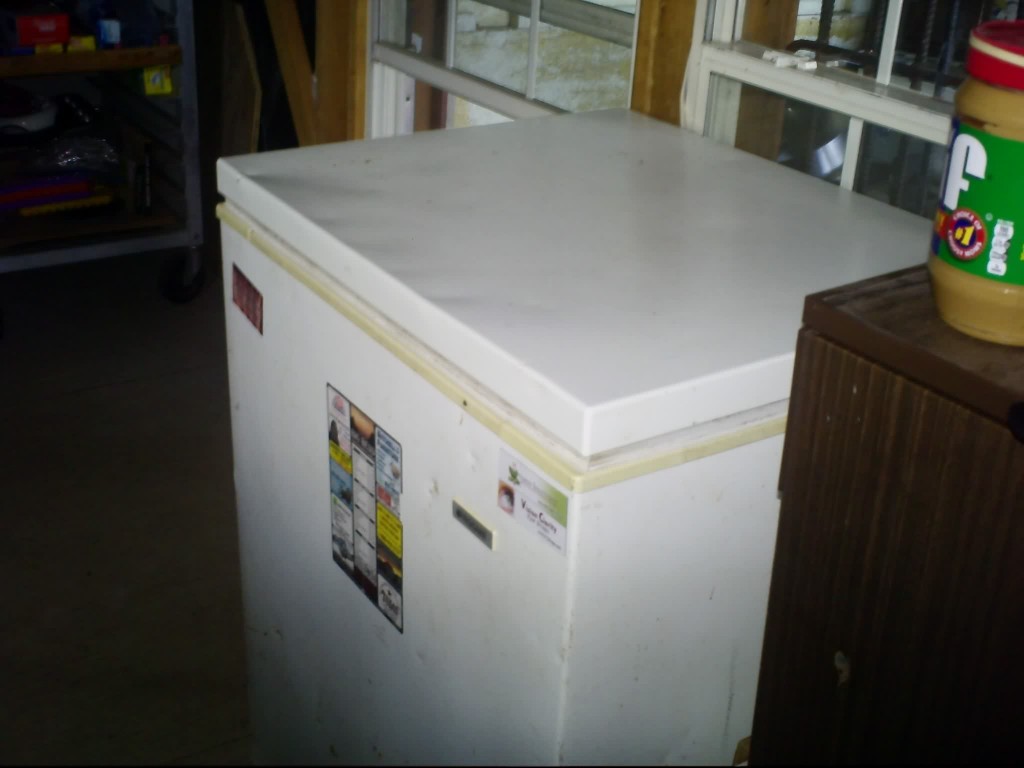
Living off-grid, I get questions from time to time, mainly about how we live, some even think we must live in a cave and eat dirt and wear skins… I said I live off-grid, but we don’t live that primitively! :) I do enjoy some of the modern conveniences of life, including having a place to keep perishable foods, aka a refrigerator.
When we first moved off-grid, in Dec ’07, we brought with us a small, dorm sized fridge, but honestly we didn’t use it much, only plugging it up on the occasions when I brought home a gallon of milk or a pound of ground beef, once the perishable food was gone, we unplugged the fridge. What I quickly found out was the standard type of fridge used up a LOT of power and they tend to be very inefficient.
I kept reading about these smart off-gridders who used a chest freezer to make a refrigerator, how can that be? Turns out that it is very simple, so simple even primitive off-gridder could do it. Here is what you need:
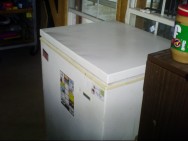
One small chest freezer. Why a chest freezer you ask? It’s simple physics, cold air sinks to the ground, that’s what is wrong with front opening fridges (and freezers), when you open the door on a front opening unit, all the cold air drops to your feet, feels good in summer, but it’s terribly inefficient, the unit now has to work harder to cool the inside again, once you quit gaping into the open door and close it. :)
Also the freezers have more insulation than refrigerators
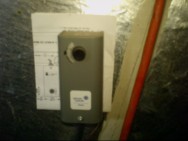
Next you need an external thermostat, this is easily purchased online, mine cost around $50.00, I use this one. I like the manual, analog, non-digital one, the reason is those do not need extra power to run, no extra batteries inside the unit itself. These will have a small box with the thermostat workings inside and a dial on the outside, a copper bulb on a long thin copper wire and the plug. The paper behind the thermostat is the instructions that came with it, we found it easiest to attach it to the wall along with the thermostat so they never get lost.
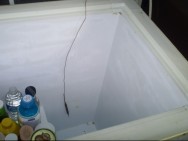
Once you have these two items, you pick out the best spot for your freezer-fridge unit, hereafter referred to as the fridge. You set the external thermostat, I keep mine at 35° F. Carefully unwind the copper coil (you don’t want to kink or break it), slip the bulb into the fridge box, if yours comes with a drain hole, that is a good spot to insert it, mine didn’t so I just placed mine through the back of the box between the box and lid, the copper wire is thin so it doesn’t interfere with the door. The bulb is where it measures temperature, I placed mine about 6 inches (+/-) from the bottom, you don’t want it fully on the bottom or at the top of the fridge, I’ve read that it shouldn’t be touching the side of the box either, but I don’t know a good way to get it to be fully separate from the wall either, it hasn’t been an issue for me.
Plug the fridge into the back of the plug on the thermostat plug, then plug that into power, close the door on the fridge and wait at least a half an hour, up to an hour. The unit will run for at least a half hour, cycle off, then on again a few more times. After the fridge comes to the temp you set on the external thermostat, that will cut off the power to the fridge. Mine runs a couple of times an hour for about 5 minutes at a time, and I’ve checked the inner temp of the box, it keeps everything at or near the 35° F I set.
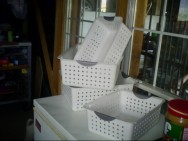
Now you insert food. That isn’t as easy as it sounds, this is a box you are filling from the top, no pretty shelves to hold your food. :(
The remedy is simple. Plastic baskets. Since your fridge might be a different size than mine, I suggest you measure yours to see what will fit. I use 2 larger and 2 smaller baskets. The smaller ones go in the bottom of the unit, the larger ones go on the “step” inside unit. I put the less often used food items in the lower baskets and the more often used items in the upper baskets. Yes you will have to remove the baskets to get to the lower foods, but that is a small price to pay, don’t you think?

I just cleaned mine out the other day, so I’ll let you see inside of it :)
I put the smaller baskets on the very bottom (at the right), with the foods I access less often. There are 2 smaller baskets for the bottom space.
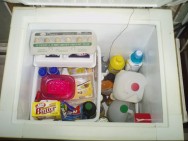
The larger baskets go on the top (at the left), two stacked up, with the less often access foods on the bottom and the more often accessed foods on the top.
Oh one thing to remember, I never put raw meat on top of other foods, I put raw meat inside of a zip baggie, place that on a plate or a bowl and put it in such a way that it can’t possibly drip down onto any other foods.
I do have to remove everything about once a month and clean the whole thing, mainly because of the water condensing on the inside. Even in our very dry area, there is still a certain amount of moisture or humidity in the air, each time I open the box, more moisture gets in, it condenses on the sides and rolls down to the bottom. I tried putting a towel in the bottom to soak up the moisture between cleanings. That was a big mistake, it became a stinky bacteria mat, trust me, it’s better for the water to sit in the bottom until it’s time to clean it out, besides it’s always a good idea to dig out all of the food, since I can’t see everything in the baskets, it’s amazing how many food items that get buried and forgotten about, out of sight, out of mind… I merely remove the baskets, check the food to see if something needs to go away or possibly just be repackaged, I clean the baskets with soap and water, I wipe out the water in the bottom of the fridge, I wipe down the sides and bottom of the inside of the unit with either a weak bleach and water solution or vinegar and water. I place the foods back in the baskets and place the baskets back in the fridge.
With the super insulation value in the freezer box, it even keeps my food cold on those few times when I use up too much power playing on the internet during cloudy days and run out of power, my fridge keeps my food cold overnight until the sun shines the following day and charges my batteries back up.
You could also do this even if you aren’t living off-grid but just want a more efficient way to store your perishable foods, this will certainly cost less to run meaning more $$$s in your pocket each month.
30 Responses
Thanks so much for this! I’m “retired” on grid, but live on a tight budget. I’ve ‘done homesteading’ so know it’s accurate to describe my situation as ‘rugged’! I try to produce extra in garden that needs winter storage. A root cellar would be ideal but I’m overwhelmed as it is – adding ‘construct root cellar’ to my project list is not going to happen! While researching using an old refrigerator, I came across ‘convert a chest freezer’. One of my rules is “don’t buy anything unless/until you’ve combed through all on-hand resources”. Eureka! I *do* have a small unused chest freezer! Serious re-wiring (as I’ve read at some sites) is not in my ‘ready skill set’. I really appreciate the external thermostat approach, and hope also to get a manual, analog, one. Last winter I stored potatoes and carrots in tubs in an unheated north room but was aware that it ruled out using the room as a heated space. Also, the room was susceptible to noticeable temp variation. I can place my converted freezer in my basement, accessible via a trap door in a pantry floor. Basement temp usually about 50dF, too warm without specialized cool space. It’ll be convenient enough as I’ve got a sidexside regular fridge/freezer for daily use. I think I’ll place some kind of very low ‘rack’ along bottom of my ‘new’ chest root crop storage to avoid any issues of long-storage contact with floor/walls inside the chest. Not sure why it would matter but ‘seems’ like it could. I’ll probably use storage tubs also to keep roots organized. BTW, I store dry beans, rice, etc – and empty jugs, even boxes, in freezers and fridges to reduce loss of cool/cold air when opening doors. I dry a lot of garden produce for storage, by air/sun if possible, elec if not; am learning what I can grow indoors in a low-therm setting for fresh-in-winter; and am vegetarian – so I don’t have a lot of need for freezer/fridge. I do have *some* need, but at times have more ‘non-perishable’ stuff in freezer/fridge than perishable!
Maggie, thanks so much for reading my article and replying, I’m so glad that I was able to help. :) Sounds like you have things going on pretty well, do you blog or write about your experiences? You seem to like writing and you have lots of personality in your words, if you do, please reply with a link, if not, you should really consider doing it, blogger.com is free and a good place to start.
Wretha
Hi all, I am still on the grid, however after reading about the freezer conversion, I purchased a small freezer. Next, I built six inches of white foam, (less for blue foam), under and around and on top of the freezer, except the back hot air outlet and side air inlet. The foam was made to create an eight inch void at the front and side. silver foil lined. I have placed several camping type cooler bricks in the freezer, however I have never needed to place these in the voids. The void space is an excellent refrigerator, free feeding off the freezer. Possibly some electric tweeking could reduce the power consumption of the freezer. As is is OK for me.
Tip… KEEP YOU PANELS CLEAN. Friend of mine installed a 3kw system and 3months later was hardly generating anything by late afternoon, nothing. Rang the installation contractor who could not get onsite for a few weeks, but mentioned OBTW you could try giving the panels a wash. Their back to the 3kw and were amazed at the amount of dirt that had collected on their panels in such a short time. Now it,s wash dog, wash the panels. BTW mine makes a great kegerator
Had our panels for 6 years and never had to wash them. Jst saying.
This is a great article and I have taken the leap and converted a chest freezer into a fridge. I have a question though. I am using a Ranco Prewired Digital Temperature Controller. I know how to set the temperature on it but how do I know where to set the dial on the actual freezer? Your thoughts would be greatly appreciated.
Hi Kelly, thanks for your question and it’s a good one! Honestly I didn’t worry about where to set mine, it was set where it was set, as long as it’s below what you are wanting it to get to, it really doesn’t matter, the external thermostat will turn it off when it gets cold enough. You can set it to the coldest temp if you wish.
Hi there, my name is chris and we made the jump from utilities in oct 12. It’s great to meet like minded folk that may have some answers to my many questions and maybe hopefully I can pass on some of my limited knowledge. I have two 100watt mono panels and six deep cycle Trojan batteries (220ah), still a tacky charge controller that came with the panels, a pure sine 2000 watt constant and 4000watt surge inverter. I have heard about the surge horror stories with an upright fridge freezer and my system will barely run a large screen LCD tv so I am doubtful that the system will power a fridge freezer ? I love this idea of the conversion. I was made promises about my system that have never worked and feel a little let down about the power availability to be quite honest. If anybody has any input I would greatly appreciate it. Everyone have a great utility free day !
I hope you have solved your problem and have upgraded your panels as you didn’t have enough of them.
I hope you got some good advice.
Have a great day, from fellow a off-grider
hello, I was looking for an answer to the moisture problem. looks like there is no way to alleviate it. I use my chest freezer conversion as a wine and beer cellar, and keep it at 55F. I have it inside our air conditioned home and moisture is still a &^%$ !
Thank you very much for this article and giving me the idea to build one ourselves.
My partner and I live COMPLETELY off the grid, and we did buy a small upright freezer so we can freeze our meats and our vegitables from our garden. Right now we are using an antique ice box as our fridge and we fill gallon milk jugs with water and freeze those to keep the ice box cold. Daily we swap the ice filled jugs with the now melted down jugs and put those back into the freezer.
But im liking your idea so we can have a much colder fridge space
I am just learning about to convert a freezer to a fridge, as I am installing solar for the power source in a house renovation off-grid. My question is –
I assume I would still need have two of them, ie to use one as a normal freezer (if I wanted to actually freeze some things)?
Colin, you are correct, if you want a freezer and a fridge using this configuration, you would need to have 2 of them, one for the fridge and one for the freezer, of course the one you run as a freezer would not need the external thermostat. I would think that even running 2 units, it would use much less power than having a standard fridge w/freezer unit.
Wretha
Are you still using the chest fridge?
With what size solar panel were you able to run it?
Bart, sorry it took so long to reply, we have 4-55 watt panels and 4-15 watt panels on our main system, that runs our chest fridge, some lights, a water pump, a small radio, a laptop and a few misc. other items. We can have as few as 2 deep cycle batteries but prefer running 4 of them on that system.
Wretha
Do you know how many kilowatt hours per day this freezer-turned-fridge uses?
Jill, I do not know how many kilowatt hours this uses, I don’t have a device to measure this, I do know that since it is so much more efficient and runs as little as it does compared to a standard fridge, it is well worth the investment if you are living on solar/battery power.
Wretha
You could put a small drain hole and add some irrigation pipe and a valve to drain the chest.
since you have 2 tiers of plastic baskets side by side inside the freezer, i wonder if replacing them with 1 or 2 wire basket shelves would make it easier pulling things out in one go and seeing everything inside as well. something like a drop down cabinet shelving, only backwards since you’re pulling it up.
do _not_ cover your freezer with blankets. the condenser is on the freezer walls. (the part that gets warm) if you do this, you will make it have to work very hard to do its cooling. the only difference here is when the power is out and the unit is not running. then you can help maintain the inside temp by covering with blankets.
Good information. If I were doing this, I would cover the fridge with a duvet or some
thing similar which hangs down the front and sides. The extra insulation really helps.
Once we put hot water in a styrofoam-insulated jug and wrapped it with an old down-filled vest. We headed south in our van
but had to return after two days due to a snow storm. We arrived home and unpacked the van and the water in the jug was still
warm! Surely this would work to keep warm air out of your fridge.
Excellent info what a simple idea. Thanks Wretha
Great article! Thanks for sharing the knowledge. I might have a solution for keeping the bulb away from the freezer wall. Take a small cube of foam, cut a slit in it. Slip the cube over the capillary tube and it should keep the bulb away from the wall. Cheers!
Thanks Bossman, sounds like a good idea… so far it hasn’t been an issue for me so far.
Wretha
Sounds good; do you have any educated guesses about energy comparison between a fridge about that size, and a converted freezer? Or just an idea about how much energy your converted freeezer uses?
Thanks for writing garden guru, I don’t have hard figures about the differences between the conventional fridge and the freezer conversion, I will say that when running a conventional dorm sized fridge, it would run about 15 minutes each half hour, and if I opened the door, it would run for 15 minutes to bring it back down to temp. The freezer fridge conversion runs about 5 minutes 2-3 times an hour, and opening the lid doesn’t necessarily make it run more.
Wretha
thanks for this helpful knowledge and taking your time to post this article
You are very welcome Janelle :)
Wretha
Great article, I’ve read a few on this subject but yours is the first to give a link for the external thermostat.
This is the route I will probably go as well since the prices on ammonia refers is so high.
Thanks
Thanks Dave, we were given an old travel trailer with an equally old ammonia fridge, it was multi-powered, it would run on 12 volt, 110 as well as propane. When we finally got around to removing the fridge from the trailer, we started smelling ammonia and realized the unit was not going to work, it was going to cost more than the thing was worth to get it fixed. That’s when I got serious about the chest freezer-fridge conversion. It has worked very well for us. Glad you were able to get some good info from the article.
Wretha